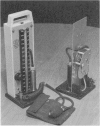Abstract
The Hawksley random zero sphygmomanometer is used in all aspects of blood pressure research, from clinical trials to evaluation of new blood pressure recorders. It is designed to reduce observer bias in blood pressure measurement. The problem is that it also underestimates blood pressure. Furthermore, this was first reported more than two decades ago. In this paper Rónán Conroy and colleagues explore the consequences of using an inaccurate instrument for important research and why prestigious organisations like the World Health Organisation continue to use it.
Full text
PDF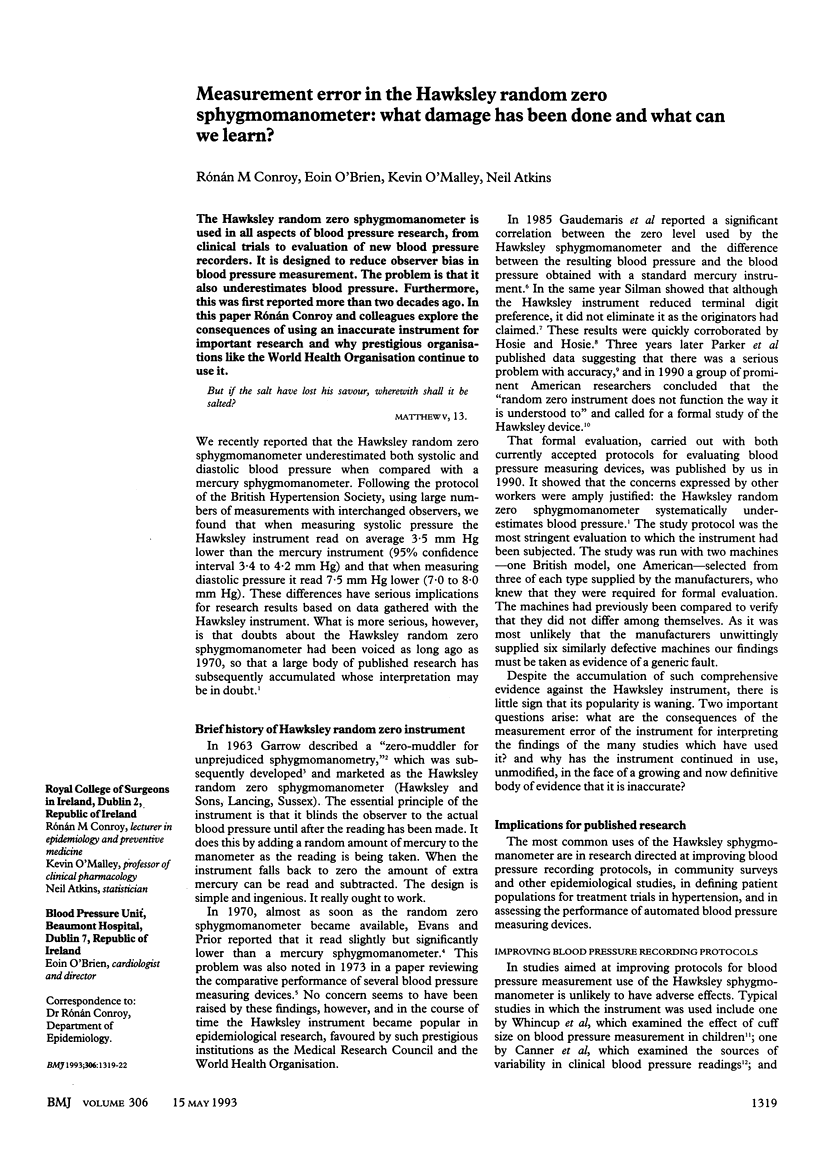
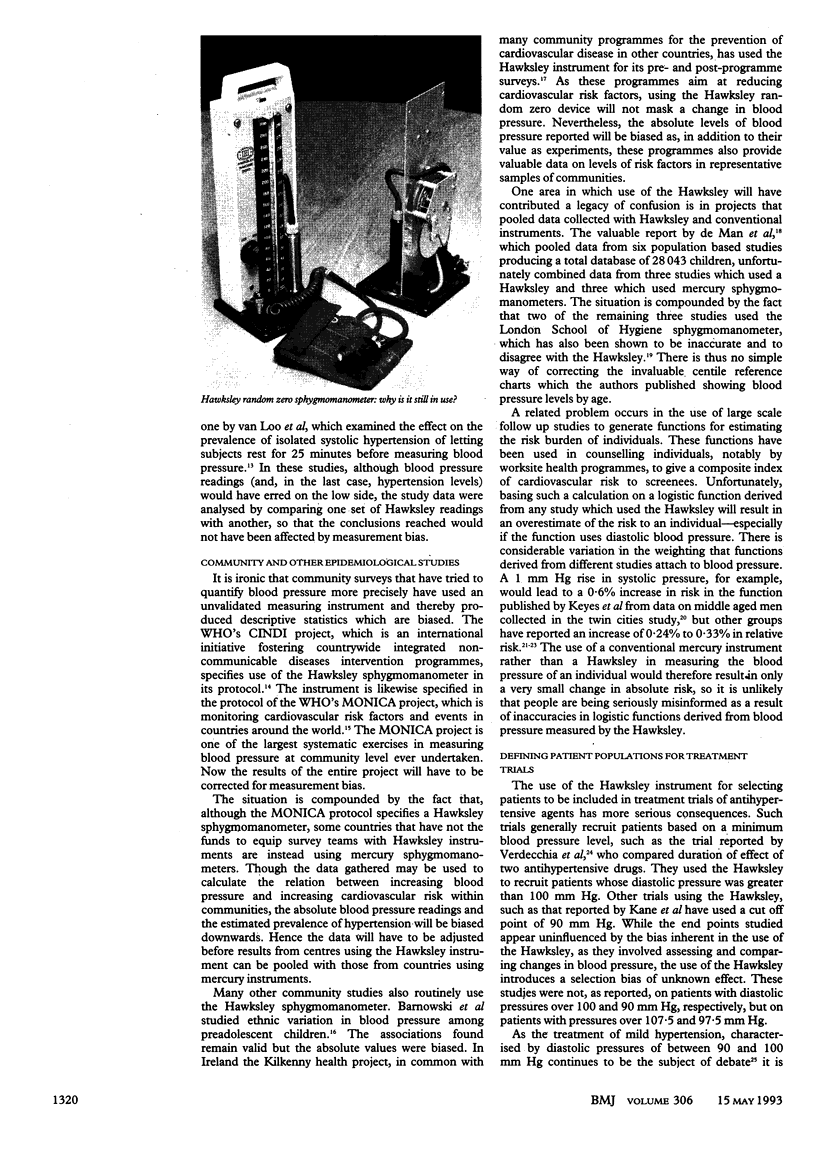
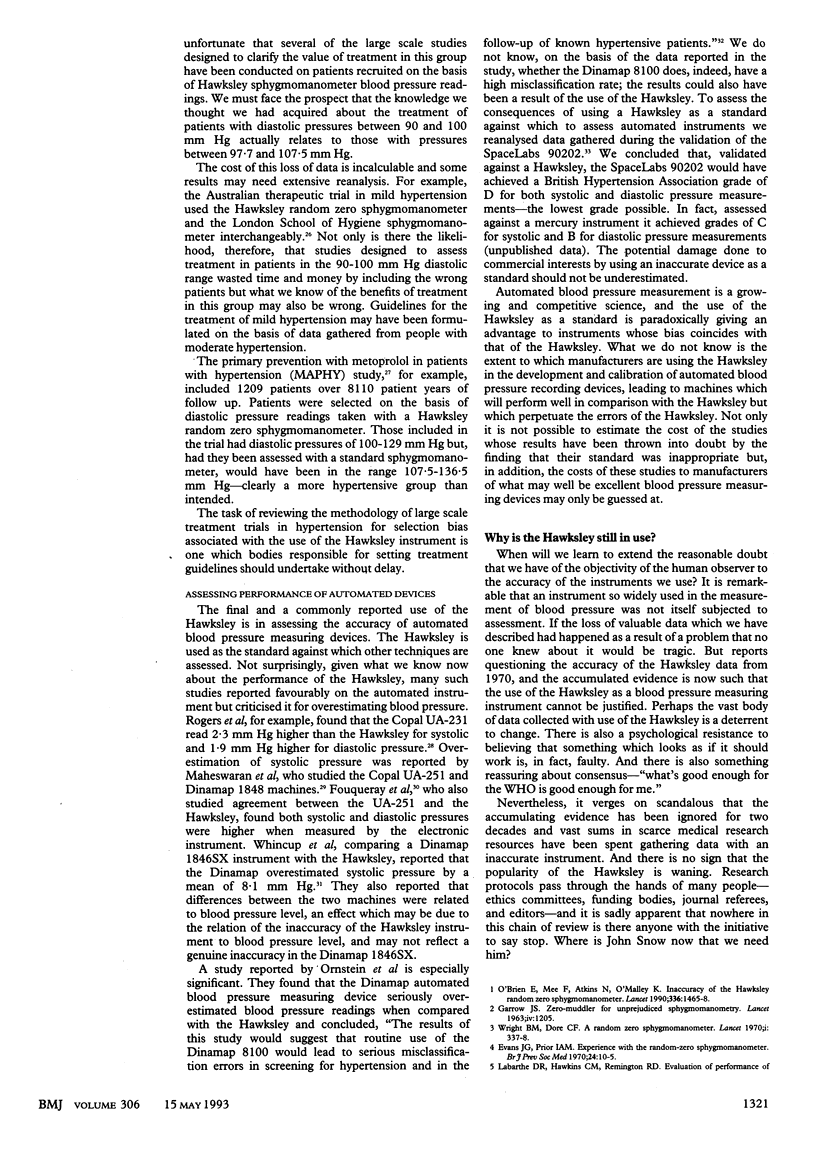
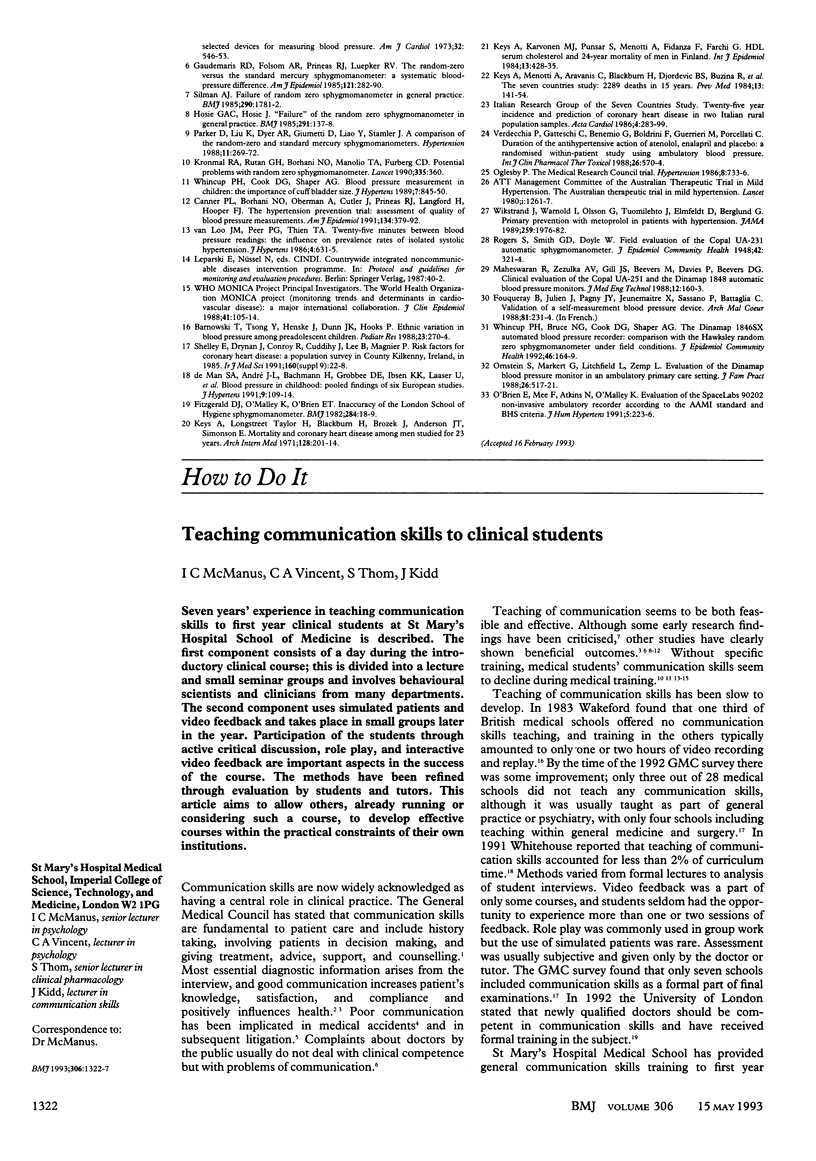
Images in this article
Selected References
These references are in PubMed. This may not be the complete list of references from this article.
- Baranowski T., Tsong Y., Henske J., Dunn J. K., Hooks P. Ethnic variation in blood pressure among preadolescent children. Pediatr Res. 1988 Mar;23(3):270–274. doi: 10.1203/00006450-198803000-00008. [DOI] [PubMed] [Google Scholar]
- Canner P. L., Borhani N. O., Oberman A., Cutler J., Prineas R. J., Langford H., Hooper F. J. The Hypertension Prevention Trial: assessment of the quality of blood pressure measurements. Am J Epidemiol. 1991 Aug 15;134(4):379–392. doi: 10.1093/oxfordjournals.aje.a116100. [DOI] [PubMed] [Google Scholar]
- Evans J. G., Prior I. A. Experience with the random-zero sphygmomanometer. Br J Prev Soc Med. 1970 Feb;24(1):10–15. doi: 10.1136/jech.24.1.10. [DOI] [PMC free article] [PubMed] [Google Scholar]
- Fitzgerald D. J., O'Malley K., O'Brien E. T. Inaccuracy of London School of Hygiene sphygmomanometer. Br Med J (Clin Res Ed) 1982 Jan 2;284(6308):18–19. doi: 10.1136/bmj.284.6308.18. [DOI] [PMC free article] [PubMed] [Google Scholar]
- Fouqueray B., Julien J., Pagny J. Y., Jeunemaitre X., Sassano P., Battaglia C., Plouin P. F. Validation d'un appareil d'automesure tensionnelle. Arch Mal Coeur Vaiss. 1988 Jun;81(Spec No):231–234. [PubMed] [Google Scholar]
- GARROW J. S. ZERO-MUDDLER FOR UNPREJUDICED SPHYGMOMANOMETRY. Lancet. 1963 Dec 7;2(7319):1205–1205. doi: 10.1016/s0140-6736(63)92929-5. [DOI] [PubMed] [Google Scholar]
- Keys A., Karvonen M. J., Punsar S., Menotti A., Fidanza F., Farchi G. HDL serum cholesterol and 24-year mortality of men in Finland. Int J Epidemiol. 1984 Dec;13(4):428–435. doi: 10.1093/ije/13.4.428. [DOI] [PubMed] [Google Scholar]
- Keys A., Menotti A., Aravanis C., Blackburn H., Djordevic B. S., Buzina R., Dontas A. S., Fidanza F., Karvonen M. J., Kimura N. The seven countries study: 2,289 deaths in 15 years. Prev Med. 1984 Mar;13(2):141–154. doi: 10.1016/0091-7435(84)90047-1. [DOI] [PubMed] [Google Scholar]
- Keys A., Taylor H. L., Blackburn H., Brozek J., Anderson J. T., Simonson E. Mortality and coronary heart disease among men studied for 23 years. Arch Intern Med. 1971 Aug;128(2):201–214. doi: 10.1001/archinte.1971.00310200037002. [DOI] [PubMed] [Google Scholar]
- Kronmal R. A., Rutan G. H., Borhani N. O., Manolio T. A., Furberg C. D. Potential problems with random zero sphygmomanometer. Lancet. 1990 Feb 10;335(8685):360–360. doi: 10.1016/0140-6736(90)90652-l. [DOI] [PubMed] [Google Scholar]
- Labarthe D. R., Hawkins C. M., Remington R. D. Evaluation of performance of selected devices for measuring blood pressure. Am J Cardiol. 1973 Sep 20;32(4):546–553. doi: 10.1016/s0002-9149(73)80046-3. [DOI] [PubMed] [Google Scholar]
- Maheswaran R., Zezulka A. V., Gill J. S., Beevers M., Davies P., Beevers D. G. Clinical evaluation of the Copal UA-251 and the Dinamap 1848 automatic blood-pressure monitors. J Med Eng Technol. 1988 Jul-Aug;12(4):160–163. doi: 10.3109/03091908809030175. [DOI] [PubMed] [Google Scholar]
- O'Brien E., Mee F., Atkins N., O'Malley K. Evaluation of the SpaceLabs 90202 non-invasive ambulatory recorder according to the AAMI Standard and BHS criteria. J Hum Hypertens. 1991 Jun;5(3):223–226. [PubMed] [Google Scholar]
- O'Brien E., Mee F., Atkins N., O'Malley K. Inaccuracy of the Hawksley random zero sphygmomanometer. Lancet. 1990 Dec 15;336(8729):1465–1468. doi: 10.1016/0140-6736(90)93177-q. [DOI] [PubMed] [Google Scholar]
- Ornstein S., Markert G., Litchfield L., Zemp L. Evaluation of the DINAMAP blood pressure monitor in an ambulatory primary care setting. J Fam Pract. 1988 May;26(5):517–521. [PubMed] [Google Scholar]
- Parker D., Liu K., Dyer A. R., Giumetti D., Liao Y. L., Stamler J. A comparison of the random-zero and standard mercury sphygmomanometers. Hypertension. 1988 Mar;11(3):269–272. doi: 10.1161/01.hyp.11.3.269. [DOI] [PubMed] [Google Scholar]
- Paul O. The Medical Research Council Trial. Hypertension. 1986 Sep;8(9):733–736. doi: 10.1161/01.hyp.8.9.733. [DOI] [PubMed] [Google Scholar]
- Rogers S., Smith G. D., Doyle W. Field evaluation of the Copal UA-231 automatic sphygmomanometer. J Epidemiol Community Health. 1988 Dec;42(4):321–324. doi: 10.1136/jech.42.4.321. [DOI] [PMC free article] [PubMed] [Google Scholar]
- Silman A. J. Failure of random zero sphygmomanometer in general practice. Br Med J (Clin Res Ed) 1985 Jun 15;290(6484):1781–1782. doi: 10.1136/bmj.290.6484.1781. [DOI] [PMC free article] [PubMed] [Google Scholar]
- Verdecchia P., Gatteschi C., Benemio G., Boldrini F., Guerrieri M., Porcellati C. Duration of the antihypertensive action of atenolol, enalapril and placebo: a randomized within-patient study using ambulatory blood pressure monitoring. Int J Clin Pharmacol Ther Toxicol. 1988 Nov;26(11):570–574. [PubMed] [Google Scholar]
- Whincup P. H., Bruce N. G., Cook D. G., Shaper A. G. The Dinamap 1846SX automated blood pressure recorder: comparison with the Hawksley random zero sphygmomanometer under field conditions. J Epidemiol Community Health. 1992 Apr;46(2):164–169. doi: 10.1136/jech.46.2.164. [DOI] [PMC free article] [PubMed] [Google Scholar]
- Whincup P. H., Cook D. G., Shaper A. G. Blood pressure measurement in children: the importance of cuff bladder size. J Hypertens. 1989 Oct;7(10):845–850. doi: 10.1097/00004872-198910000-00010. [DOI] [PubMed] [Google Scholar]
- Wikstrand J., Warnold I., Olsson G., Tuomilehto J., Elmfeldt D., Berglund G. Primary prevention with metoprolol in patients with hypertension. Mortality results from the MAPHY study. JAMA. 1988 Apr 1;259(13):1976–1982. [PubMed] [Google Scholar]
- Wright B. M., Dore C. F. A random-zero sphygmomanometer. Lancet. 1970 Feb 14;1(7642):337–338. doi: 10.1016/s0140-6736(70)90709-9. [DOI] [PubMed] [Google Scholar]
- de Gaudemaris R., Folsom A. R., Prineas R. J., Luepker R. V. The random-zero versus the standard mercury sphygmomanometer: a systematic blood pressure difference. Am J Epidemiol. 1985 Feb;121(2):282–290. doi: 10.1093/oxfordjournals.aje.a113998. [DOI] [PubMed] [Google Scholar]
- de Man S. A., André J. L., Bachmann H., Grobbee D. E., Ibsen K. K., Laaser U., Lippert P., Hofman A. Blood pressure in childhood: pooled findings of six European studies. J Hypertens. 1991 Feb;9(2):109–114. doi: 10.1097/00004872-199102000-00002. [DOI] [PubMed] [Google Scholar]
- van Loo J. M., Peer P. G., Thien T. A. Twenty-five minutes between blood pressure readings: the influence on prevalence rates of isolated systolic hypertension. J Hypertens. 1986 Oct;4(5):631–635. doi: 10.1097/00004872-198610000-00017. [DOI] [PubMed] [Google Scholar]



